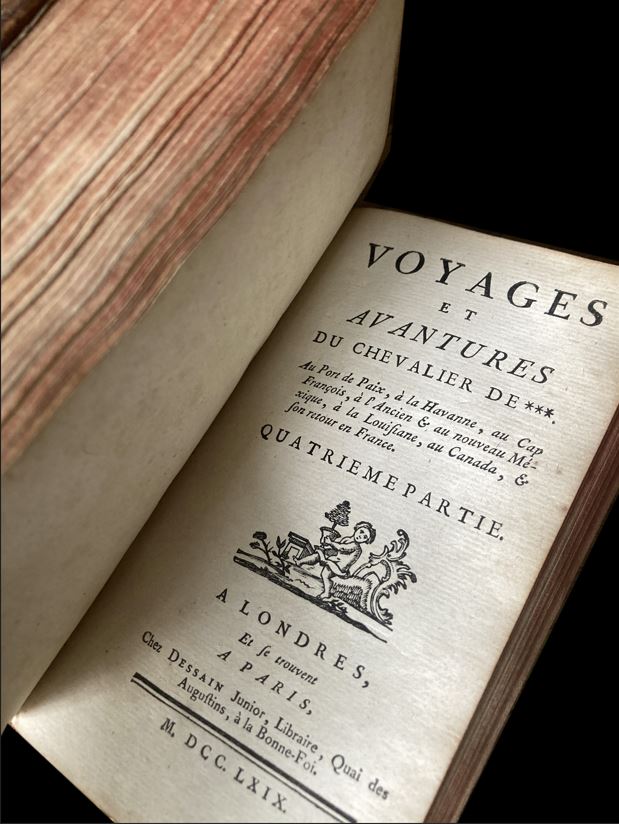Adventures of Chevalier de ***, A Rare West Indian Romance
- by Thibault Ehrengardt

Voyages & Avantures du Chevalier de ***... (Londres, Paris—1769)§ is a hard book to find. According to the Rare Book Transaction History, two copies only were offered for sale over the past 150 years: one in 1922 by Anderson Galleries, and one in 1875. There was no copy listed on Abebooks at the time these lines were written, and you could find the two last volumes (out of four) on eBay.fr for 280€. It was published by Jean-Baptiste Dessain, aka Dessain Junior, whose bookshop, Á la bonne foi (At Good faith’s), was located Quai des Augustins, in Paris, France. We don’t know much about the printer§§, but we know even less about the anonymous author, Chevalier de ***. On the description of the copy they sold in 1922, Anderson Galleries state: “The author has escaped discovery. (...) P. Gagnon, the Canadian Bibliographer, states that there is not much to be found about him. Even Winsor's Narrative and Critical History, that storehouse of bibliographical notes, fails to mention the work at all.” He introduces himself as coming from “one of the most ancient families in the Nivarais (a French province)” but at a time when several fake voyages were published, his relation is suspicious.
It hasn’t been listed as fake, though—and all the people that Chevalier de *** meets and names, like the governors of the French West Indies, famous people, etc, were indeed in charge in the West Indies at the time. Yet, some parts will raise your eyebrows, including some precise memories of insignificant and 10-year-old events (he says in his preface that he used the notes he took at the time), the relation of the author’s feminine conquests, the interspersed stories of outsiders (always boring)—in a word, it sounds like a novel on many occasions. Yet Chevalier de *** seems to know what he’s talking about when he describes the way illegal trade was conducted at the time in the region, and how people ran their business in the West Indies. But as a Jamaica specialist, I was far less convinced by his alleged trip to the island in 1729. His succinct description of Jamaica seems to be taken from an obsolete relation—he mentions Spanish Town and Port Royal, but not a word about Kingston, which had by then become the most or second most important trading place in the island. Port Royal had partly sunk following the 1692 earthquake—a dramatic event that made the headlines as far as Europe, as the city was then the buccaneers’ hen. But our Chevalier apparently never heard about it: “At the time, since the English had taken possession of the island (1655), not a single earthquake had been felt in Jamaica.” It is very well acknowledged that several earthquakes hit Jamaica even after the one in 1692. I don’t know about the rest, but I’d bet our Chevalier never actually went to Jamaica.
Notwithstanding, although bordering on boredom at times, this book gives a rather interesting insight in the society of the West Indies at the time. Social interactions with the governors, the slaves, or the traders are hardly as carefully described in other travel books. At the end of the day, although not the most fascinating read, it’s still worth reading—especially if you think that life is sometimes better with a hint of romance.
Thibault Ehrengardt
§ Voyages & Avantures(sic) du Chevalier de ***, contenant les voyages de l’auteur dans les isles Antilles françoises du vent de l’Amérique septentrionale, y compris les Islaes Caraibes de Saint-Vincent, Sainte-Lucie & la Dominique ; & dans celle de Saint-Thomas, appartenant aux Danois. Á Londres, Et se trouvent à Paris chez DESSAIN Junior, libraire, Quai des Augustins, à la Bonne Foi. 1749.
- 4 in-12° volumes. No engraving. Let’s note that every part has a varying full title depending on the places visited by the author.
§§ The printer, Dessain Junior, was located Quai des Augustins, in Paris, where many important booksellers used to be, including Goué. He named his shop Á la Bonne Foi (To Good Faith’s), which reminds us of the famous Á la Bonne Foi Couronnée (To Crowned Good Faith’s) operated by Charles de Sercy in the late 17th century. His trade card features two hands shaking in good faith, just like on Sercy’s logo—so there was a link here. In 1766, Dessain’s card read: “Buy and sell all kinds of books, in French or else. Sell and buy cabinets and book collections.”